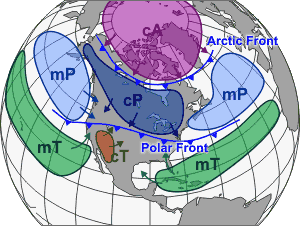Air Masses

The air masses in and around North America include the continental arctic (cA), maritime polar (mP), maritime tropical (mT), continental tropical (cT), and continental polar (cP) air masses.
Credit: NOAA
Air is not the same everywhere. In North America, for example, cold and dry air covering thousands of miles flows south from the Arctic, especially in winter, and warm moist air flows north from the Gulf of Mexico. These different types air are called air masses.
An air mass is like a team whose players are all wearing the same uniform. In this case, the players are air, not people. And the uniforms that they wear are the similar characteristics such as temperature and humidity. Like sports teams, when two air masses come together, there is often turbulence. The turbulence of the two air masses moving together can cause clouds and thunderstorms to form. The border between two air masses at the Earth’s surface is called weather front.
Air masses are given a two-part name that describes the humidity and temperature characteristics of the region where they form. The first part of an air mass’ name describes its humidity. Air masses that form over the ocean, called maritime air masses, are more humid than those that form over land, called continental air masses. The second part of the name describes the temperature of the air mass, which depends on the latitude where it formed. Air masses that form near the equator or in the tropics (equatorial or tropical air masses) are warmer than air masses that form in polar areas or in the Arctic (polar or arctic air masses).
The word that describes humidity (maritime or continental) is paired with the word that describes temperature (equatorial, tropical, polar or arctic). For example, if an air mass forms over a tropical ocean, it is called maritime tropical. If an air mass forms over land in the far north it is called continental polar.
An air mass can change as it moves into different environments. For example, if a continental polar air mass moves into warmer areas and over the ocean the air will warm and moisture may evaporate from the ocean surface into the air, adding humidity.
Cold and warm air masses usually come together in middle latitudes areas such as the United States, where they form weather fronts and can produce massive storms.